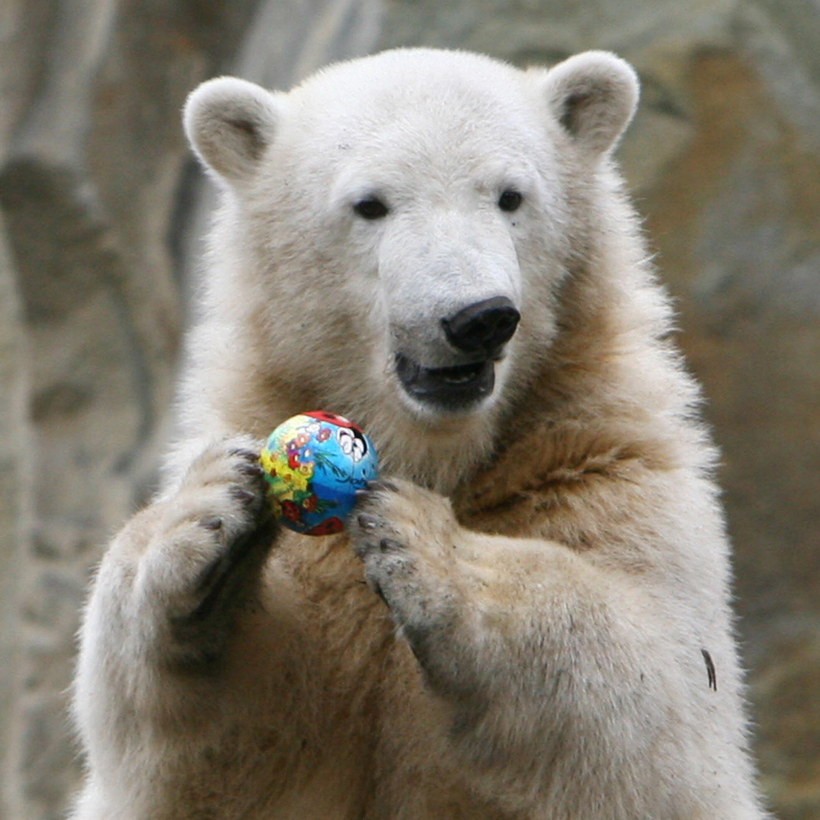As I wandered the galleries of the Itsanitaq Museum, in Churchill, Canada, one sculpture in particular caught my eye. Tucked among the soapstone and basalt carvings in the sub-Arctic town’s Inuit-and-Indigenous-art collection, the grayish-white piece featured a polar bear, standing on its hind legs and holding a stone boulder. Below, a sleeping walrus appeared entirely unaware of the bludgeoning threat.
I snapped a photo of the bizarre tableau on my iPhone. Months later, I’d largely forgotten about the sculpture when I came across a recently published study titled “Do Wild Polar Bears Use Tools When Hunting Walruses?”
For more than 200 years, Inuit in Greenland and the eastern Canadian Arctic have told stories of polar bears bashing walruses on the head with stone or ice blocks—as captured in the carving I’d seen in Churchill. Yet explorers and naturalists often dismissed such accounts, writing them off as myths.
A study found supporting evidence that polar bears have, on occasion, used tools to get food. Some recent GoPro-camera footage even shows a female polar bear sliding a large block of ice around before throwing it into the water at a seal. Such tool use, long believed to be a marker of superior intelligence, was further evidence that bears belong to the upper stratums of animal cognition.
This wasn’t surprising to Jennifer Vonk, a comparative psychologist at Oakland University, in Michigan, who has published what is among the most authoritative bodies of research on how bears understand the world around them.
Some recent GoPro-camera footage shows a female polar bear sliding a large block of ice around before throwing it into the water at a seal.
I’d reached out to her while researching my book, Eight Bears, to get a better grasp on bear intelligence. I knew that brown bears had been found to make complex mental inventories of their wild surroundings, that pandas in China’s Qinling Mountains use the ingenious method of smearing themselves with horse manure to boost their cold tolerance, and that sun bears use complex facial mimicry to communicate with others of their kind. But I wanted to know how bears ranked among some of the other species considered to be the world’s smartest.
“I don’t like to talk about intelligence—it’s a bit anthropocentric—but in terms of quickness to acquire discrimination and the markers of some of the things we would call ‘intelligence,’ bears have outperformed the great apes I’ve worked with on many tasks,” Vonk told me.
Vonk didn’t set out to study the minds of bears. Like many animal psychologists, she was primarily interested in primate cognition and the lives of social animals. Bears, though they live in close-knit family groups as cubs, are considered solitary beings.
Shortly after Hurricane Katrina battered the U.S., Vonk began working with a lonely chimpanzee named Joe at the Mobile Zoo, a small roadside attraction in Wilmer, Alabama. Joe had been surrendered by a Hollywood trainer and was kept in a barn with a family of four American black bears—Elsie, the mother; and her three adult children, Brutus, Dusty, and Bella. As her experiments with the chimpanzee wore on, Vonk began to wonder whether the forgotten bears might also benefit from some mental stimulation.
Vonk devised an experiment to test the bears’ capacity for simple discrimination between objects. She began by teaching the bears how to use a touch-screen device. Then she instructed them to indicate the difference between an image of a bear and an image of a human. If the bear touched the black-bear image, it received a food reward. If it touched the image of the human, it heard a buzzer.
She would cycle through about 20 different sets of randomly paired pictures in different conceptual categories, and once the bears reached 80 percent accuracy, she would swap out the set of photos to see if the bears could maintain the same precision. This would indicate that they had generalized the information.
Could they tell the difference between a primate and a non-primate, such as a horse? Between an herbivore and a carnivore? Between an animal and a landscape? They could. “They were the most rapid learners,” she told me.
In another of Vonk’s cranial explorations, she gauged black bears on their ability to make the mental connection between the two-dimensional image of an object and its real-life manifestation. In others, she expanded on this concept to see if the bears could understand numbers and 2D or 3D objects at the same time. For example, if she showed a bear an image of three almonds, would it understand that this meant it would receive three almonds? When Vonk showed an American black bear at the Detroit Zoo a unique set of objects and their corresponding images, the bear was capable of transferring their meaning from one to the other. This is something that gorillas have never mastered, said Vonk.
That’s something to keep in mind when heading into bear country this summer. “We know they’re super-clever, just in terms of getting into food at campsites,” Vonk added.

Gloria Dickie is a global climate-and-environment correspondent at Reuters. Her book, Eight Bears: Mythic Past and Imperiled Future, is out now from W. W. Norton & Company


